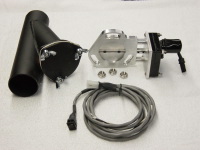|
Cutouts vs. Aftermarket Exhausts
While some of us love
the sound of a straight pipe V8, or the high-pitched ring of an Italian
motor, there are some of us who just love the bliss of silence. When it
comes to exhaust flow, exhaust noise, and power, you will quickly see
that they are all linked. You can’t have one without the others being
involved in the equation. This causes a problem for some of us that
want good exhaust flow and power, but also want the car to be quiet as
well.
It’s no surprise that
just a straight through exhaust will also be the highest flowing
exhaust. There is a reason why we all used to stick toilet paper in our
ears at Nascar Races when we were kids. To make a lot of power you need
to have a lot of flow, and what comes with a lot of flow, is a lot of
noise.
In comes the exhaust
cutout. It was a way that automotive enthusiasts could drive their cars
daily, or go out for a night on the town with a nice quiet exhaust.
Then take that same car to the track and remove the cut-out block
plates and open up the exhaust to not only rattle your ear drums out,
but make some great power as well. The only problem with this type of
cut-out was that one had to manually remove the block off plate. Not
only can this be a daunting task based on the cutouts location, but
also means that the gain in exhaust flow can’t be called upon whenever
the user desires.
How an Electric Exhaust
Cutout Works

An Exhaust Cutout is
really a Y pipe that is welded into the stock exhaust pipe. One of the
Y’s legs continues on the exhaust as normal while the other Y leg can
be vented to the atmosphere. Now with the leg vented to the atmosphere
the user has control to cap it off leaving the exhaust to flow as the
OEM manufacturer intended, or un-cap the exhaust to dump right to the
atmosphere.
Electric Exhaust Cutouts

An Electric Exhaust
Cutout is one where the block off plate is controlled by an electronic
solenoid. The beauty of this design is that the amount of exhaust flow,
and therefore sound, can now be controlled by the user at any given
time. The solenoids on the market, used with exhaust cutouts, are all
12v solenoids wired to a relay, so there is no problem wiring them into
the cars electronics. A switch is then run to a location in the vehicle
so that the driver has complete control over the exhaust cutouts
blocker plate.
Electric Cutout vs
Aftermarket Performance Exhaust
This is really a tough
comparison. It really comes down to preference. Some just love the
sound of a particular brand of muffler so much, they are willing to
give up performance gains for that sound, while others just want flat
out performance no matter how much hearing loss it causes. Could an
Electronic Cutout be the best of both worlds? I think the best way we
can do both these setups justice is to just describe the pros and cons
of each.
Electric Exhaust Cutout
*Pros
- Best exhaust flow of
any exhaust system on the market.
- Will offer the highest
horsepower of any exhaust setup.
- Can be the quietest
exhaust on the market.
- Decibels of sound are
infinitely adjustable.
*Cons
- None, unless you are
going after a specific sound for your car.
Aftermarket Exhaust
*Pros
- Can offer a specific
engine sound.
- Can be a lighter set-up
than the stock exhaust.
- Can offer more power
than the factory stock exhaust.
*Cons
- Not as free flowing as
a Cutout therefore not as much power.
- Not as quiet as a stock
exhaust, and therefore can “drone” at certain speeds.
Ultimately it’s up to you
which one is your cup of tea.
LOVE THAT SOUND!
|
